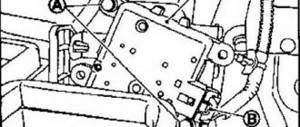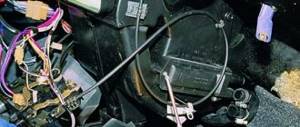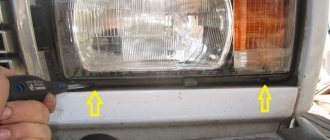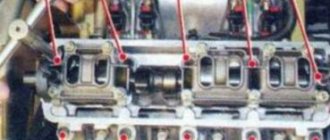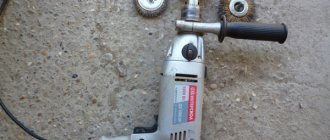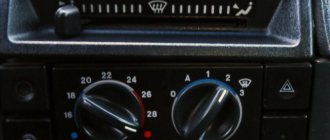The cooling system of the UAZ Patriot engine contains an element called a “viscous coupling” or, as it is sometimes called, a “fluid coupling” - on which the fan is located. It is necessary to protect against overheating and is activated only when the engine temperature begins to exceed operating limits.
The viscous coupling on the UAZ Patriot is designed in such a way that it is connected to the engine crankshaft not directly, but through special disks, between which there is a working fluid. When starting a cold engine, the viscous coupling spins at a very low speed, much less than the number of engine revolutions.
Then, as the engine warms up, the metal plate in front of the viscous coupling heats up from the radiator and bends outward, which releases a special ball that closes the hole in the inner disk. It turns out that the working fluid has nowhere else to go and remains between the disks.
The working fluid used is a special one, so-called “dilatant”, based on silicone. When heated and stirred, it expands and becomes more like thick glue. Next, the fan speed increases to eventually equal the crankshaft speed. A serviceable clutch turns with little effort when the engine is turned off.
Pros and cons of viscous coupling
Let's start with the disadvantages, because it is because of them that owners prefer to install electric fans on the UAZ Patriot instead of a viscous coupling. And the most significant disadvantage, perhaps, is poor engine airflow at low speeds - for example, in traffic jams or when driving over rough terrain at low speed. After all, the efficiency of a viscous coupling directly depends on these very revolutions.
Besides this, there are other disadvantages:
- Additional load on the engine. The viscous coupling takes away part of the engine power, this is especially noticeable when overtaking on the highway, when the operating speed is almost in the red zone of the tachometer. Acoustic comfort also suffers - a characteristic noise and howl appears.
- There is no way to force the fan to turn on at full power, for example, in the same traffic jams.
- The clutch makes it difficult to access the idler rollers and drive belts, which significantly complicates and increases the time spent on repairs.
- There is a danger of fan blades coming off at high speeds, as well as the risk of damage to the main radiator from flying fan fragments, which may require expensive repairs with a complete replacement of antifreeze/antifreeze. Now imagine that this could happen on the highway, somewhere far from home.
- Cannot be repaired. The faulty clutch is replaced with a new one, although you can try drilling a few holes and fixing it with bolts so that it always rotates. But this repair method is only suitable for summer; in winter, the engine will take a very long time to warm up.
- A simple and fairly reliable design that can work for years without any maintenance.
- It is installed on the UAZ Patriot from the factory, so you will not have to modify anything if it is replaced.
- Does not create a load on the electrical part of the car.
As you can see, the viscous coupling has more disadvantages, so many Patriot owners eventually come to the idea of replacing it with electric fans.
How to remove viscous coupling
Let's start with the disadvantages, because it is because of them that owners prefer to install electric fans on the UAZ Patriot instead of a viscous coupling.
And the most significant disadvantage, perhaps, is poor engine airflow at low speeds - for example, in traffic jams or when driving over rough terrain at low speed. After all, the efficiency of a viscous coupling directly depends on these very revolutions. Besides this, there are other disadvantages:
- Additional load on the engine. The viscous coupling takes away part of the engine power, this is especially noticeable when overtaking on the highway, when the operating speed is almost in the red zone of the tachometer. Acoustic comfort also suffers - a characteristic noise and howl appears.
- There is no way to force the fan to turn on at full power, for example, in the same traffic jams.
- The clutch makes it difficult to access the idler rollers and drive belts, which significantly complicates and increases the time spent on repairs.
- There is a danger of fan blades coming off at high speeds, as well as the risk of damage to the main radiator from flying fan fragments, which may require expensive repairs with a complete replacement of antifreeze/antifreeze. Now imagine that this could happen on the highway, somewhere far from home.
- Cannot be repaired. The faulty clutch is replaced with a new one, although you can try drilling a few holes and fixing it with bolts so that it always rotates. But this repair method is only suitable for summer; in winter, the engine will take a very long time to warm up.
What are the advantages?
- A simple and fairly reliable design that can work for years without any maintenance.
- It is installed on the UAZ Patriot from the factory, so you will not have to modify anything if it is replaced.
- Does not create a load on the electrical part of the car.
As you can see, the viscous coupling has more disadvantages, so many Patriot owners eventually come to the idea of replacing it with electric fans.
Usually, the viscous coupling from a UAZ Patriot car is not difficult to remove, although if the device has not been removed for a long time and the bolts have become sour, a hammer may be needed. So, the sequence of actions is as follows:
- First, remove the fan casing (diffuser). Using a small flat head screwdriver, remove the spacer clip pins located on the top of the diffuser and remove the clips. After this, the casing is removed from the engine compartment through the top.
- The nut securing the fan to the pump hub is unscrewed. Here you can’t do without a 32 open-end wrench. Attention, the nut has a left-hand thread, that is, you need to unscrew it to the right (if you look at the front of the car).
- Be sure to secure the drive belt by pressing it with your hand in the gap between the temple pulley and the power steering pulley. Otherwise, you will not be able to unscrew the nut. If even after this the nut does not unscrew, try to break it off with sharp blows on the wrench with a hammer.
- Unscrew the nut a little and, holding it with a wrench, rotate the fan impeller to dismantle it. Keep in mind that the fan weighs a lot, so do everything carefully.
- Remove the fan and remove the viscous coupling by unscrewing the four mounting bolts around the perimeter.
All engines used in cars of the Ulyanovsk Automobile Plant are equipped with a classic liquid water cooling system. The system is divided into two circuits - small and large. The large circuit includes the water jacket in the block and the cylinder head, the heater radiator and the engine cooling radiator, the thermostat and the pipe system, the small circuit includes everything except the cooling radiator. The circuits are separated by a thermostat, which, depending on the coolant temperature, either opens or closes the inlet to the radiator.
However, the cooling system of UAZ engines also has some peculiarities. For example, shutters are installed in front of the radiator (behind the radiator grille), which allow the driver to regulate the flow of air passing through the radiator. The blinds are controlled from the cabin using a special handle; they allow you to regulate the engine temperature within a fairly wide range depending on the outside air temperature.
• Permanent drive;• Drive through a fluid coupling (also known as viscous coupling and viscous coupling);• Drive through an electromagnetic clutch.
Engines with permanent fan drive have not been produced for a long time; such a system was used on early modifications of the UAZ-31512 (UAZ-469B) and some other models. However, already in the 20th century, the old ZMZ-402 and UMZ-417 engines began to be equipped with a viscous coupling, and today almost all engines installed on UAZ vehicles have a hydraulic coupling for the fan drive.
The viscous coupling plays an important role in the engine cooling system, so let’s look at this part in more detail.
The viscous coupling is a simple and reliable solution that significantly simplifies the design of the fan drive, allowing the elimination of many parts. The viscous coupling is a single compact unit through which the fan impeller is connected to the water pump pulley; this unit does not require any electrical connections or connection to control elements, and operates independently from other engine parts.
The fluid coupling performs one function - changing the rotation speed of the cooling fan impeller depending on the engine temperature. This is achieved by the fact that when heated, the coupling increases the transmission of torque from the pump to the fan impeller, and when cooled, it reduces the flow of torque.
The viscous coupling is mounted directly onto the water pump drive pulley using a flange, and the fan impeller is attached to the coupling housing. Therefore, the viscous coupling always rotates with the pump pulley, regardless of the current engine temperature.
Fluid coupling has a number of advantages over other types of fan drive, which are especially important for off-road vehicles operated in difficult conditions. For example, the use of a viscous coupling minimizes the role of the blinds in front of the cooling radiator, although in UAZ vehicles with a permanent fan drive the driver constantly has to control the blinds.
Also, in engines with a fluid coupling, there is no need to turn off the fan or remove the belt when overcoming fords - when entering the water, the viscous coupling cools down and turns off the fan. Also, the fan stops rotating due to increased resistance of the medium, but if in the case of direct drive or electric drive, forced braking of the fan impeller is fraught with belt wear and breakage, then for the viscous coupling this is not at all dangerous.
Finally, a viscous coupling simply simplifies the entire fan drive, reduces fuel consumption and somewhat reduces engine noise (especially at idle).
UAZ vehicles use viscous couplings with a two-stage control system. Such couplings have a slightly more complex design than single-chamber viscous couplings of earlier releases, but they provide better fan performance and prevent some negative effects. Couplings of different models have a fundamentally identical design, differing only in some details. Therefore, we will consider here the general structure of the viscous coupling of UAZ cars.
The basis of the coupling consists of two parts: the housing and the rotor located inside it. The rotor is installed inside the housing through bearings on the rotor shaft; the shaft itself goes into a flange, with the help of which the fisc coupling is mounted on the water pump pulley. The rotor divides the internal space of the housing into two cavities, which, in turn, are also divided into two chambers by special plates (intermediate washers, they are rigidly connected to the housing).
On the side of the working chambers, the rotor and washers are equipped with annular ribs, which greatly increase the surface area of the chambers and increase the efficiency of the coupling. In essence, working chambers are “labyrinths” of cavities in which working fluid circulates. This solution makes it possible to abandon the use of a package of friction discs and simplify the design of the viscous coupling.
The front washer has four inlet channels located on opposite sides. One channel on each side is connected to the front working chamber, the second - to the rear working chamber. Moreover, windows are made in the rotor to supply liquid to the rear working chamber. In the coupling body or between the front plate and the body there are bypass (return) channels that supply fluid from the working chambers to the front reservoir.
The inlet channels are closed with a wide bimetallic plate, which is pressed against the front washer. A pin is passed through the center of the front wall of the coupling body, which holds the bimetallic plate, and on the outside is connected to a spiral bimetallic spring. The bimetallic spring is rigidly connected to the bimetallic plate through a pin, and the plate together with the pin can rotate through a certain angle, opening or closing the inlet channels.
However, when the bimetallic plate is rotated, only one of the inlet channels opens; the second channel opens at a higher temperature due to the bending of the bimetallic plate. Thus, the inlet channels and the bimetallic plate form a valve system that opens and closes depending on the temperature of the coupling.
At the end of the rotor there are oblique teeth (rim gear), which play the role of a pump for pumping working fluid from the working chambers to the front reservoir.
The coupling body is usually made of aluminum alloy, which has high thermal conductivity. On the outside, the housing has fins that increase the surface area of the coupling. Both of these solutions are aimed at reducing the thermal inertia of the viscous coupling - thanks to the heat-conducting material and a developed system of fins, the coupling heats up and cools down faster, ensuring a change in fan speed with minimal lag behind changes in engine temperature.
About the electric fan
The electric fan covers all the disadvantages that the viscous coupling had. After installing it, it will be difficult not to notice the following improvements:
- The engine will stop overheating in traffic jams.
- You can force the electric fans to turn on at full power at any time, even while standing still, or program them to turn on based on temperature.
- The electric fan will not take power away from the motor.
- You can install two electric fans at once for reliability; if one of them breaks or is not enough for normal cooling, the other will take over its role.
- Access to rollers and belts is provided.
From the factory, on a UAZ Patriot with air conditioning, a so-called “sparka” is installed in front of the air conditioner radiator (on the street side) - two electric fans in a plastic case. But they have little effect on the main radiator, and besides, they make a lot of noise. Therefore, if you have already decided to install electric fans instead of a viscous coupling, you can safely remove them.
Installation process
To install an electric fan, it is not at all necessary to visit a service center; everything can be done independently at home. First of all, it is necessary to select or manufacture a base for electric fans (frame or “screen”) that matches the size of the engine cooling radiator.
Dimensions of a homemade screen so that nothing touches the body anywhere
Secure the fans to the frame using studs, close all gaps between the electric fan and the frame using door seals - this is necessary to create a directed flow of cold air for effective cooling of the radiator. A standard plastic (or iron) viscous coupling fan casing is needed for exactly the same thing.
Electric fans can be selected from another car, various options are possible, choose the one that is most affordable for you. Alternatively, you can take electric fans from a Toyota Celica as a basis, ordering their delivery from Vladivostok, as the person in the video did.
The following electric fans are also suitable: “Termal 404615S” - analogues: “Nissens 85616”, “Sat ST-DTW1-201-0”. Electric fan from Volga or VAZ 2110. In some cases, there is no need to make a homemade screen; everything fits on the “original” mounts. In the case of “Termal 404615S” you don’t have to redo anything.
The best way to install electric fans is one in which everything is connected to the connectors of standard electric fans, then there is no need to purchase additional equipment, such as:
How to change the pump (water pump) on a UAZ Patriot
The pump (water pump) is the main component of the cooling system of any internal combustion engine (internal combustion engine) with water cooling, that is, where some kind of liquid circulates all the time, be it antifreeze, antifreeze or even water. The pump looks like a pump with an impeller (blades), which creates fluid movement through the system.
Sometimes it happens that the pump for some reason stops functioning normally, as a result of which the engine begins to heat up and can easily jam, and this is already a large repair expense, in fact, a major overhaul. To avoid all this, you need to replace the part with a new one every few thousand km, as prescribed by the regulations, or drive until characteristic signs of an imminent pump breakdown appear.
Causes and signs of failure
There may be several reasons why pumps on UAZ Patriot break down. The main one is wear of the pulley hub bearing, due to coolant entering it (the bearing) through a leaky seal (oil seal), for example. But there may be other reasons:
- Violation of the integrity of the oil seal. This can happen if you use cooling system “flushes” from an unknown manufacturer.
- Damage and corrosion of the pump impeller (blades), mainly due to low-quality antifreeze.
- The most “harmless” malfunction is a leak of coolant through the sealing gasket between the pump and the engine block; here you can simply change the gasket, or even better, use a sealant.
As a rule, the pump begins to signal that something is “wrong” with it long before it completely breaks down and ceases to perform its direct function, namely, to cool the engine. What are these signs:
- The easiest way to check a pump is to look at it. If the seal is already leaking fluid, you will see streaks around the pump. Traces of some modern antifreezes are clearly visible under ultraviolet light.
- If there are no visual signs of failure, start the engine and listen; if an incomprehensible whistle or grinding sound is heard, there may be problems with the bearing or impeller. A “dead” bearing also causes play in the pulley hub.
- Does the engine constantly get hot, even in cool weather? This is a direct signal to first check the operation of the pump. It may be that a seemingly intact pump that does not make any sounds no longer pumps liquid, for example, because the blades were “eaten” by counterfeit antifreeze or they were simply broken off (some of them).
Repair or replacement
The pump for a UAZ Patriot with a ZMZ 409 engine is usually replaced entirely with a new one, although if you wish, you can try to repair it yourself. There are VN repair kits for many UAZ engines, including the 409 engine. The repair kit includes new:
- bearing
- stuffing box
- impeller
But first you will have to remove the old pump from the engine.
Before removing the pump from the car, you need to prepare the car itself and the necessary tools, you will need:
- open-end wrench 12 (or socket 12);
- hexagon 6;
- 7mm spanner for unscrewing clamps;
- flat blade screwdriver;
- mounting blade.
Viscous cooling fan coupling: where it is located and how it works
The fan rotation speed changes smoothly, steplessly; a fan with a viscous coupling never turns on and off instantly
In all-wheel drive transmissions of passenger vehicles with a longitudinal engine position, a standard viscous coupling performs the functions of an ersatz differential or a special locking element that complements a conventional differential. However, from a design point of view, the device is represented by a plurality of round driving and driven plate elements with projections and holes, which are located inside a completely waterproof housing filled with dilatant liquid.
The fan rotation speed depends on the heating of the engine: the more the viscous coupling is heated, the more the inlet channel opens, and the more liquid enters the working chamber.
In the absence or insignificant volume of automobile oil inside the working chamber, free rotation of the drive disk is observed. Only in the process of gradual warming up of the engine and increasing the temperature of the antifreeze does the bimetallic plate heat up and expand, which causes the opening of the intake valve system, penetration of the working fluid into the chamber and an increase in the speed of rotational movements of the ventilating impeller. As the adhesion coefficient decreases, the difference in the rotational speed of the housing and the viscous coupling drive shaft increases noticeably, which slows down the operation of the fan impeller.
How to check a viscous coupling (using the example of UAZ Patriot)
The engine cooling system of the UAZ Patriot is equipped with a standard viscous coupling with a fan. This device provides reliable protection against overheating by turning on when the engine temperature goes beyond the established operating parameters. The viscous coupling does not have a rigid connection to the crankshaft, and starting a cold engine causes it to rotate at low speed.
The use of a viscous coupling minimizes the role of the blinds in front of the cooling radiator, although in UAZ vehicles with a permanent fan drive the driver constantly has to control the blinds
It is very difficult to independently diagnose a breakdown of a viscous coupling in normal mode, but there are several ways to easily verify the functionality of such a device. To check the viscous coupling of the UAZ Patriot cooling fan, you should take a closer look at the speed of the mechanism when the engine is turned on, cold and warm.
UAZ Patriot - replacing viscous coupling with electric fans
The cooling system of the UAZ Patriot engine contains an element called a “viscous coupling” or, as it is sometimes called, a “fluid coupling” - on which the fan is located. It is necessary to protect against overheating and is activated only when the engine temperature begins to exceed operating limits.
The viscous coupling on the UAZ Patriot is designed in such a way that it is connected to the engine crankshaft not directly, but through special disks, between which there is a working fluid. When starting a cold engine, the viscous coupling spins at a very low speed, much less than the number of engine revolutions.
Then, as the engine warms up, the metal plate in front of the viscous coupling heats up from the radiator and bends outward, which releases a special ball that closes the hole in the inner disk. It turns out that the working fluid has nowhere else to go and remains between the disks.
The working fluid used is a special one, so-called “dilatant”, based on silicone. When heated and stirred, it expands and becomes more like thick glue. Next, the fan speed increases to eventually equal the crankshaft speed. A serviceable clutch turns with little effort when the engine is turned off.
DIY troubleshooting
Standard disassembly of a viscous coupling involves removing the device, dismantling the impeller, unscrewing a pair of mounting pins, draining the working fluid, thoroughly washing the inside with gasoline and drying it. After filling with new PMS-10000 silicone oil, the device is mounted back.
To troubleshoot a viscous coupling or replace it, you must first remove the device:
- Remove the fan casing by removing the pins and spacer clips.
To make the key fit, its ends can be sharpened with a grinder
You need to press the belt between the temple pulley and the power steering pulley
Insert the key from above between the two blades
If the cause of incorrect operation of the viscous coupling is a leak of silicone liquid from the base, then the following actions are performed:
- The viscous coupling removed from the water pump is disassembled.
- The pin is carefully removed, since on the surface of the device there is a plate with a spring covering the hole.
- The device is placed horizontally, and lubricant in an amount of 15–30 ml is carefully and slowly poured inside using a special syringe.
- All excess silicone liquid is removed from the surface using a rag.
- After installing the pin, the device is mounted in its original place.
If there is a variety of unusual noise in the cooling radiator, the bearing will need to be replaced. For this purpose, it is necessary to drain the oil and disassemble the assembly using a special puller. After installing the new bearing, the device is mounted in the reverse order, after which new silicone fluid is poured.
A special automotive device - a viscous coupling that rotates the cooling fan using liquid - quite often fails. It is possible to fix only the simplest breakdowns on your own, so in the most difficult cases you need to contact a service center with auto mechanics who specialize in working with these types of devices.
Removing the fan and viscous coupling
• Remove the fan casing To do this, use a small screwdriver to remove the pins of the spacer clips in the upper part of the casing, remove both clips, and then lift the casing upwards.
• Unscrew the nut securing the fan to the water pump hub using a 32 mm open-end wrench.
Attention: the nut has a left-hand thread, so it must turn to the right.
• When loosening the nut, press on the water pump drive belt to keep the hub from turning. If the nut does not budge, hit the lock handle with a suitable hammer to loosen it. You can then unscrew the nut by rotating the fan impeller. Be careful not to drop the fan.
• If necessary, remove the viscous coupling. by unscrewing the four mounting bolts (indicated by arrows).
Completion of assembly
After installing all the timing parts and the cylinder head cover, all that remains is to mount the previously removed components: crankshaft sensor, pump, alternator belt, power steering belt, fan pulley, oil sump and radiator. After assembly, fill in oil and antifreeze. Connect the high-voltage wires and connect the negative wire to the battery terminal.
Removing the fan and viscous coupling
• Remove the fan casing To do this, use a small screwdriver to remove the pins of the spacer clips in the upper part of the casing, remove both clips, and then lift the casing upwards.
• Unscrew the nut securing the fan to the water pump hub using a 32 mm open-end wrench.
Attention: the nut has a left-hand thread, so it must turn to the right.
• When loosening the nut, press on the water pump drive belt to keep the hub from turning. If the nut does not budge, hit the lock handle with a suitable hammer to loosen it. You can then unscrew the nut by rotating the fan impeller. Be careful not to drop the fan.
• If necessary, remove the viscous coupling. by unscrewing the four mounting bolts (indicated by arrows).
A viscous coupling is a mechanical device that transmits torque using a special viscous fluid. Knowing how to check the viscous coupling of a cooling fan, it is quite possible to independently determine the reason for its incorrect functioning, and then decide on the feasibility and scope of repair work.
